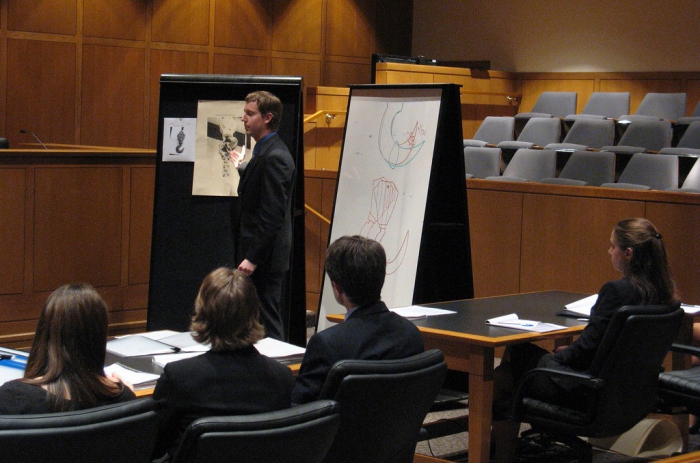Each crime, based on the theory of criminal law, consists of mandatory elements and signs that form them. The properties of crimes are reflected in the dispositions of legislative norms and make it possible to distinguish one wrongful act from another. With their help, a corpus delicti is formed, the presence of which is the basis for criminal prosecution.

Corpus delicti
The structure of a crime (SP) is understood to mean a system of subjective and objective signs (elements) of an act that are predefined in the hypothesis and disposition of the criminal law norm and characterize the corresponding illegal act as a crime.
The significance of the offense is as follows:
- the presence of a joint venture is a reason for criminal liability;
- in accordance with the obligatory signs of the composition of a certain crime, the process of its qualification takes place;
- The joint venture is a necessary tool for distinguishing between criminal acts and non-criminal;
- corpus delicti denotes the category of gravity of the crime committed;
- thanks to the joint venture, the boundaries of the punishability of an unlawful act are determined.
The absence of a corpus delicti means that in the committed action / inaction there are no signs of a crime or its corpus delicti, which is prescribed by law.

Signs of composition
Signs of a joint venture is a specific, legally significant, property of an act, the presence of which is a prerequisite for recognizing an act as a crime.
Signs of corpus delicti can be fixed both in the General part of the Criminal Code of the Russian Federation (inherent in all types of crimes), and in Special (characterizing specific offenses). As a rule, the display of the sign of the joint venture is contained in that part of the criminal law norm, which discloses the prescribed rule of conduct and is the main one.
Each property of a crime must:
- be compatible with others, in conjunction with them, determine social danger and wrongfulness;
- limit a specific crime from other similar offenses;
- be fixed by law, directly spelled out in the rule of law;
- be characteristic of all crimes of the same kind.
Mandatory signs and optional
All properties of the joint venture are divided into mandatory (basic) and optional (additional). Mandatory elements of a crime are part of all unlawful acts, their absence cancels the criminal nature of actions. These include public danger, guilt, the object of the offense, the achievement by the subject of a certain age and his sanity.
The optional features of the joint venture are properties that are inherent only to certain offenses; they characterize the specifics of specific crimes. This is a causal relationship, consequences, subject of assault, place, time, concomitant situation of the crime, purpose, motives and a special subject. Optional signs of a crime can be aggravating or mitigating circumstances when considering a case, as well as be a mandatory crime for certain types of offenses.

Permanent and variable signs
Depending on its stability and immutability, the signs of a joint venture can be variable and constant.
The permanent properties of the composition are those features of the crime that do not change throughout the entire duration of the relevant criminal law and do not depend on the specific circumstances of the crime. Consequently, variable signs are features of the crime that can be transformed regardless of changes in the text of the article and other points.
Permanent signs of a joint venture are stable both in time and in space, i.e. they mean the same thing throughout the territory where this law applies. In the process of legal proceedings, it is unacceptable to ignore these properties.
Variable signs of a crime can be blank or evaluation. Moreover, the first type of variable properties is a redirection to another branch of law (normative norm, which can be changed regardless of the criminal law), and the content of the second type is determined in the process of law enforcement on the basis of certain circumstances of the case, a systematic explanation of legal norms and the legal consciousness of the person who applies them.
Evaluation features
Separately, it is worth considering such variable signs of corpus delicti as estimated. These properties of the joint venture are characterized by the fact that their essence is determined to a greater extent by the legal consciousness of a lawyer who applies the rule of law, of course, taking into account the requirements of the Criminal Code and the circumstances of the relevant case.
Evaluation features of the composition are closest to the changing situation, which is studied and evaluated by law enforcement agencies. Therefore, these properties have received just such a name.
Evaluating properties are, for example, such concepts of the UKRF as “substantial harm”, “grave consequences”, etc. These theses are not disclosed by any legislative act, therefore only a court in each individual can decide on the presence of precisely these features in the composition case.

Elements of corpus delicti
Qualitatively homogeneous features of the joint venture in criminal law are grouped together and form elements of the composition. So properties can be combined depending on their content or volume. The elements of the composition include: the object, subject, objective and subjective side of the criminal act. According to the content of these particular components of the offense, they are distinguished from each other, for example, murder from theft or insult from slander.
Elements of corpus delicti are interconnected. For the presence of an offense, all of these links are required.
Object and subject
The object of corpus delicti is public relations, which are the goal of a criminal act that creates a threat to them or harms them. Only the most significant social relations for humanity and the state are taken under the protection of the Criminal Law, the circle of which is constantly changing, depending on changes in society.
The very social (social) relations are the actual relationship between people, jur. individuals and the state on the implementation of their own interests and rights, the performance of their duties, powers and tasks.
The subject of the crime is a certain material part of the object of the joint venture, exerting influence on which the offender harms social relations. For example, in the case of theft, the object of the composition is a property relationship, and the subject is a stolen item.
Object classification
In Criminal Law there are the following types of crime objects: general, species, generic and direct. Such a division is considered to be vertical.
A common object is the sum of all social relations that are taken under the protection of the Criminal Law. Such a view is concretized by defining a species, generic, and direct object.
A generic object is a combination of social relations that have a homogeneous relationship and are protected by criminal law.Generic objects are listed in the titles of the chapters of the Special Part of the Criminal Code of the Russian Federation.
A species composition object is a narrower group of social relations, values, interests of the same species. This object of crime occupies an intermediate meaning between the family and immediate objects.
The direct object of the joint venture is specific social relations, one or another good, interest, which is protected by law, which is directly committed a criminal assault. It may coincide with the generic object or be already him.
Horizontal classification of objects of crime includes the main, optional and additional types. This division is appropriate, for example, when encroaching on several objects at once. So, in the theft, which was committed with penetration into the premises, the main object is the right to property, and an additional - to the inviolability of the home. As for the optional object, it is those relations which, in the case of the commission of the corresponding unlawful act, are damaged and in others not. For example, with hooliganism public order always violated, that is, it is the main object, and harm to the health, property or dignity of the person, depending on the specific crime, i.e., are optional features.

Objective side
Objective signs of corpus delicti are grouped into such a link as the objective side of the offense. This element of the joint venture is a combination of external signs of an offense, which are:
- unlawful socially dangerous act (expressed in action or inaction), committed in a certain place, at a certain time and with the help of specific means and tools;
- consequences that occur after the commission of a crime;
- causal relationship between the act and the results.
The place, instrument, time of the crime, the situation are additional properties of the objective side of the crime.
Subject
The subject of a crime is a sane person who has committed an unlawful act and has reached the age at which the corresponding legal liability arises.
The sanity and age of the subject of crime are mandatory properties of this element. Usually, criminal liability comes from the age of 18, but also the Criminal Code of the Russian Federation provides a list of crimes for the commission of which a person will have to bear responsibility if he has reached the age of 14.
The sanity of the subject is determined by two criteria: psychological and biological. Only if they are combined can we talk about the full sanity of the offender. The psychological aspect in this case is the ability of the offender to understand the actual circumstances of the crime and its social significance (intellectual criterion), the ability of a person to manage his actions (volitional criterion). A biological criterion is a state of mind of a person at the time of the commission of a crime, determined on the basis of a medical report forensic psychiatric examination.
A special subject of a crime is an individual who committed a crime that is prohibited by law and meets both the mandatory features inherent in the subject of the joint venture and the specific (optional) in a particular offense.

Subjective side
Elements of corpus delicti include the subjective side. It represents the attitude of the offender to the deed expressed in the assessment and understanding of his actions, as well as in the desire to obtain certain results.
In fact, the subjective side of the composition is expressed in guilt, and is also additionally indicated by motive and purpose.Guilt is an obligatory sign of an offense provided for by law and consists in the mental attitude of a person in the form of intent or negligence to his criminal acts, as well as to their consequences.
Intent, as a form of guilt, is divided into direct and indirect. An offense committed with direct intent is the action / inaction of a person who was aware of the social danger of his own actions, foresaw and wished for the onset of socially dangerous consequences. Indirect intent is a situation where the offender was aware of the danger of actions and assumed the possibility of harm, damage, but did not want such results, although he was aware of them or did not care about them.
Negligence is divided into negligence and frivolity. Frivolity is a form of guilt in which the offender foresees a general danger and adverse consequences due to his actions / inactions, but without sufficient reason, he assumed that he could prevent them. In turn, negligence is a form of guilt in which the offender did not assume the onset of such danger and consequences, although he could and should have foreseen them.
The motive of crime is an optional sign of a joint venture. It represents the motivation, guided by which, the offender committed an unlawful act. The goal is the desired result that a person wants to get when committing a socially dangerous act.
The motive and purpose of the crime is always revealed during the investigation of the case, as it allows characterizing the personality of the criminal and qualifying what he has done.
Types of crime
Depending on the nature and level of social danger, the elements of crime are divided into basic, qualified and privileged. The main joint venture is a typical composition, expressed in the most characteristic features inherent in a crime. A qualified joint venture is characterized by an increased degree of danger compared to a standard joint venture (for example, an offense by prior conspiracy or unlawful act against a minor). A privileged joint venture is a corpus delicti that contains signs mitigating responsibility when comparing it with the main corpus, this type is found in practice much less often than qualified.
Depending on what the structure of the crime is, the joint venture is divided into simple and complex. In turn, simple ones - for blank and descriptive ones, and complex ones - for compositions of ongoing and continuing crimes, compositions with two forms of guilt and two objects, as well as compositions with repeated or alternative actions / consequences. In simple elements of a crime, a sign is contained only once, and in complex ones they can double (for example, in a joint venture there are two objects for encroachment).
Formulations such as formal and material also stand out. A material joint venture is a composition that provides, as a mandatory feature, the imminent onset of socially dangerous consequences, physical or material harm (murder). A formal joint venture is a composition in which it is not necessary to establish a specific content of socially dangerous consequences, although, of course, their presence is mandatory (slander).

Thus, in this article, through a detailed analysis of the properties and elements, a characteristic of the corpus delicti is presented. The values of its various features and the classification of SP are considered.








